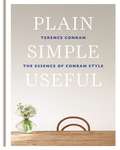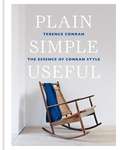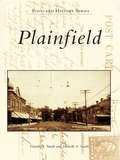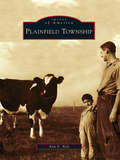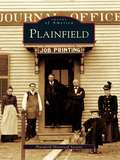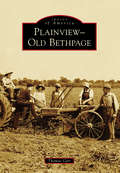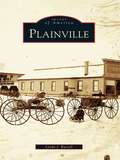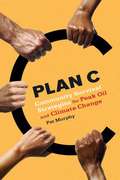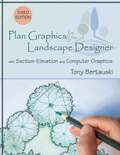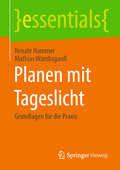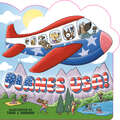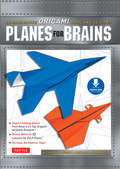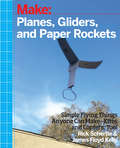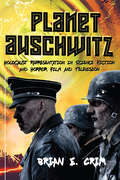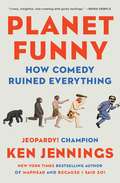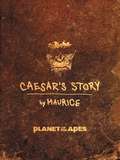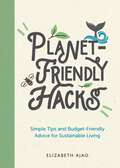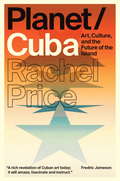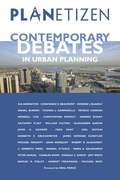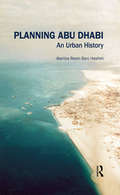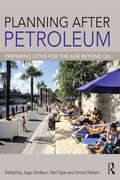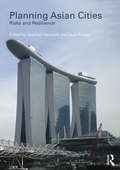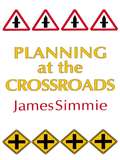- Table View
- List View
Plain Simple Useful: The Essence Of Conran Style
by Terence ConranTerence Conran has always believed that objects - and surroundings - that are plain, simple and useful are the key to easy living. By being practical and performing well over time, they are as much the antidote to superficial styling as they are to the shoddy and second-rate. Applied to the home as a whole, this discerning approach results in interiors that are effortlessly stylish, confident and timeless, with plenty of room for the expression of personal taste.Plain Simple Useful is organized according to the main activities that take place at home. Inspirational interiors, many of which are Conran's own, and a number of projects designed by him exclusively for this book, provide all the guidance you need to tailor-make your own storage. The book also features iconic examples of classic designs that will enhance any home, as well as a peek behind the closed doors of those well-ordered cupboards, larders and other stowing spaces that contribute so much to easy living.
Plain Simple Useful: The Essence of Conran Style
by Sir Terence Conran'A handsome yet joyful manual for easy, stylish living.' - Architectural DigestTerence Conran always believed that objects - and surroundings - that are plain, simple and useful are the key to easy living. By being practical and performing well over time, they are as much the antidote to superficial styling as they are to the shoddy and second-rate. Applied to the home as a whole, this discerning approach results in interiors that are effortlessly stylish, confident and timeless, with plenty of room for the expression of personal taste. Plain Simple Useful is organized according to the main activities that take place at home. Inspirational interiors, many of which were Conran's own, provide all the guidance you need to tailor-make your own storage. The book also features iconic examples of classic designs that will enhance any home, as well as a peek behind the closed doors of those well-ordered cupboards, larders and other stowing spaces that contribute so much to easy living.This updated edition of the book features a new chapter on plain, simple, useful style outdoors with elegant contemporary ideas for eating and relaxing spaces outside.
Plainfield (Postcard History)
by Timothy J. Smith Michelle Y. SmithPlainfield is the oldest community in Will County. The area was originally home to the Potawatomi Indians who lived along the DuPage River when the French fur trapper Vetel Vermette came to settle in the region. Jesse Walker, a Methodist minister, along with his son-in-law James Walker, came to the area and built a log cabin on the east side of the DuPage River in 1828. James built a permanent sawmill on the river by 1830 in a grove of trees known as Walker's Grove, south of present-day Plainfield. The village of Plainfield was platted in 1834 by Chester Ingersoll. This book, through vintage postcard images, offers a unique view of Plainfield's rich history, including scenes of its early business district, village streets, and the fabulous Electric Park, as well as early schools and churches.
Plainfield Township
by Ann ByleLovely plains and beautiful fields greeted settlers eager to put down roots in the area north of the growing city of Grand Rapids. The northernmost point of the Grand River and its environs, including the Rogue River joining the Grand nearby, offered folks everything they needed: river and road travel, good farmland, plenty of forestland, and enough space to grow and prosper. Soon the area was known as Plainfield Township, with the bustling Plainfield Village at its center. Small communities grew up around the township, including Belmont and Comstock Park that exist today but also Konkle Town and Childsdale, which do not. Plainfield Village is gone as well, but the spirit of those early pioneers lives on. Today Plainfield Township is a combination of city and country, businesses and farms, and longtime residents and those just discovering the beauty of this area that still boasts plains and fields.
Plainfield: Views Of Plainfield Connecticut (Images of America)
by Plainfield Historical SocietyThere are two dozen places in the United States named Plainfield, but Plainfield, Connecticut, was the first. When it was incorporated in 1699, Colonial governor Fitz-John Winthrop named the town for its rich, fertile fields along the Quinebaug River. During the 1700s, the town was transformed from Native American country to a farming community populated by English settlers. In the 1800s, textile mills were built along the Moosup and Quinebaug Rivers, and Plainfield became an industrial town attracting workers from all over New England, Canada, and Europe. Today the textile industry is gone, and the surviving mills have been converted to other uses. Located in the northeastern part of the state, Plainfield is in the heart of the breathtaking Quinebaug-Shetucket National Heritage Corridor.
Plainview-Old Bethpage
by Thomas CarrPlainview–Old Bethpage presents an intriguing story of two vibrant Long Island communities that share a colorful 300-year-old history. They were once quaint farming communities that almost overnight found themselves facing seismic cultural changes. In just 10 years, from 1950 to 1960, the combined population of Plainview and Old Bethpage soared from 2,000 to over 33,000. Plainview–Old Bethpage presents a journey back in time to the Native Americans, the settlers who followed, the farmers who worked the land, and the thousands who came to make a better life for their families. Discover why every town surrounding Plainview–Old Bethpage has a railroad station but it does not. Read about the resident who raised a Confederate flag during the Civil War and drew the ire of his neighbors. Ride along with race car drivers as they hurtle along dirt roads at breakneck speed. Learn about the deadly brawl on Election Day in 1890, the infamous Plainview kidnapper who got the electric chair, and a local company’s role in molding a national memorial to Vietnam veterans.
Plainville
by Lynda J. RussellOriginally known as the Great Plain, Plainville was the last town to separate from Farmington. In 1830, a post office was established in the new community and the name was changed. The town officially incorporated in 1869. The early economy consisted of farmers, millers, tin workers, tanners, chair makers, and blacksmiths. In 1828, the Farmington Canal opened and Plainville's population blossomed. It soon became a commercial center and new industries and manufacturing developed. This book documents Plainville's early-17th-century settlers, such as the Root, Newell, Hooker, Lewis, and Hamlin families, and follows the town's fascinating evolution to the present. Through stunning photographs, readers will delight to see Plainville's past unfold.
Plan C: Community Survival Strategies for Peak Oil and Climate Change
by Pat MurphyA sustainability expert goes beyond renewables, calling on us to combat the climate crisis with a new, low-energy way of life.Concerns over climate change and energy depletion are increasing exponentially. Mainstream solutions still assume that some miracle will cure our climate ills without requiring us to change our energy-intensive lifestyle. But switching from fossil fuels to renewable energy sources isn’t enough. We need a Plan C.In response to the converging crises of Peak Oil, climate change, and increasing inequity, sustainability expert Pat Murphy offers an inspiring vision of community and curtailment. Where cooperation replaces competition, we can deliberately reduce consumption of consumer goods. Plan C shows how each person's individual choices can dramatically reduce CO2 emissions, offering specific strategies in the areas of food, transportation, and housing.
Plan Graphics for the Landscape Designer: with Section-Elevation and Computer Graphics
by Tony BertauskiMany professional landscape architects and designers embrace the practice of rendering plan drawings by hand as an artistic approach that supports the design process. Tony Bertauski uses abundant illustrations to train aspiring designers in the essential drawing techniques used to craft presentation graphics while learning the essentials of design. He guides students through the tools and techniques of drawing that are often overlooked in the classroom so that students can complete assignments on their own outside the lab. Student designers will learn to create plans that not only appeal aesthetically, but communicate effectively with clients.
Planen mit Tageslicht: Grundlagen für die Praxis (essentials)
by Renate Hammer Mathias WambsganßNeue Erkenntnisse zur Wichtigkeit ausreichender Tageslichtversorgung im Innenraum haben planungsrelevante Änderungen normativer Vorgaben nach sich gezogen. Renate Hammer und Mathias Wambsganß veranschaulichen die neuen Anforderungen und erläutern die Möglichkeiten zur planerischen Umsetzung. Die Autoren klären, wann Tageslichtversorgung und Besonnung als ausreichend gelten, welche Qualitäten die Sichtverbindung nach außen erfüllen muss und wie Blendung durch Tageslicht zu begrenzen ist. Angaben zur melanopischen Wirkungsweise von Tageslicht bieten einen Einstieg in den planerischen Umgang mit nicht-visuellen Kriterien. Ein weiteres Kapitel zeigt die Schnittstellen mit anderen Aspekten der Bauplanung.Die Autoren:Dr. Renate Hammer studierte Architektur, Solararchitektur und Philosophie in Wien und Krems sowie Urban Engineering in Tokio. 2015 gründete sie das Institute of Building Research & Innovation. Sie unterrichtet einschlägig an der Kunstuniversität Linz und der FH Campus Wien. Prof. Mathias Wambsganß studierte Architektur an der Universität Karlsruhe (TH). 2014 gründete er das Büro „3lpi lichtplaner“ in München. Er ist langjähriges Mitglied im Vorstand der LiTG e.V. und wurde 2007 als Professor an die TH Rosenheim berufen.
Planes USA!
by Jo ParkerExplore America in this cloud-shaped board book! Buckle up and grab a seat on this plane full of pups, pooches, and other fun animals!Welcome aboard! Flying from New York to L.A., and making stops along the way... See 12 exciting cities across the USA!
Planes for Brains
by Richard L. Alexander Michael G. LafosseMake the best paper airplanes around with this easy-to-follow origami book. Enthralled with origami from a young age, world renowned origami and paper crafter Michael LaFosse has used those skills to design and perfect paper airplanes for decades. In Planes for Brains, LaFosse presents 28 original paper origami models that incorporate innovative functional and aesthetic details like faceted flaps, ailerons, canards and spoilers that really work. The sense of proportion and balance, and an ingenious nose and fuselage locking system, define these signature models, which are instant classics. Readers accustomed to folding simple darts and wings will bet thrilled and challenged by the folding maneuvers in these pages. Planes for Brians comes with great value-included are: 28 fun-to-do projects Step-by-step instructions Expert tips on techniques and folds Downloadable video tutorial Great for paper airplane enthusiasts as well as fans of unique origami works and parents with kids. Scissors, tape, glue are not required! Paper airplane models include: Lock Nose Dart Flying Fox Shuttle Dart F-102 Delta Jet Nifty Fifty And many more...
Planes for Brains
by Richard L. Alexander Michael G. LafosseMake the best paper airplanes around with this easy-to-follow origami book.Enthralled with origami from a young age, world renowned origami and paper crafter Michael LaFosse has used those skills to design and perfect paper airplanes for decades. In Planes for Brains, LaFosse presents 28 original paper origami models that incorporate innovative functional and aesthetic details like faceted flaps, ailerons, canards and spoilers that really work. The sense of proportion and balance, and an ingenious nose and fuselage locking system, define these signature models, which are instant classics. Readers accustomed to folding simple darts and wings will bet thrilled and challenged by the folding maneuvers in these pages. Planes for Brians comes with great value-included are: 28 fun-to-do projects Step-by-step instructions Expert tips on techniques and folds Downloadable video tutorial Great for paper airplane enthusiasts as well as fans of unique origami works and parents with kids. Scissors, tape, glue are not required!Paper airplane models include: Lock Nose Dart Flying Fox Shuttle Dart F-102 Delta Jet Nifty Fifty And many more...
Planes, Gliders and Paper Rockets: Simple Flying Things Anyone Can Make--Kites and Copters, Too!
by James Floyd Kelly Rick SchertleDo helicopters need more or less energy to stay in the sky than an airplane? What pushes a rocket to leave the atmosphere? Why can airplanes have smaller motors than helicopters? Help your students learn the answers to these and other questions! Written for educators, homeschoolers, parents--and kids!--this fully illustrated book provides a fun mix of projects, discussion materials, instructions, and subjects for deeper investigation around the basics of homemade flying objects. With the projects in this book, you can spend more time learning and experimenting, and less time planning and preparing. Complete with download links to PDF templates that expand your teaching, this is your one-stop manual for learning about, interacting with, and being curious about airflow, gravity, torque, power, ballistics, pressure, and force. In Make: Planes, Gliders, and Paper Rockets, you'll make and experiment with: Paper catapult helicopter--add an LED light for night launches!Pull-string stick helicopterRubber band airplaneSimple sled kite25-cent quick-build kiteAir rockets with a parachute or a gliderFoam air rocketRocket standsBounce rocketLow- and high-pressure rocket launchers
Planet Auschwitz: Holocaust Representation in Science Fiction and Horror Film and Television
by Brian E. CrimPlanet Auschwitz explores the diverse ways in which the Holocaust influences and shapes science fiction and horror film and television by focusing on notable contributions from the last fifty years. The supernatural and extraterrestrial are rich and complex spaces with which to examine important Holocaust themes - trauma, guilt, grief, ideological fervor and perversion, industrialized killing, and the dangerous afterlife of Nazism after World War II. Planet Auschwitz explores why the Holocaust continues to set the standard for horror in the modern era and asks if the Holocaust is imaginable here on Earth, at least by those who perpetrated it, why not in a galaxy far, far away? The pervasive use of Holocaust imagery and plotlines in horror and science fiction reflects both our preoccupation with its enduring trauma and our persistent need to “work through” its many legacies. Planet Auschwitz website (https://planetauschwitz.com)
Planet Funny: How Comedy Took Over Our Culture
by Ken JenningsA Kirkus Reviews Best Book of the Year The witty and exuberant New York Times bestselling author and record-setting Jeopardy! champion Ken Jennings relays the history of humor in &“lively, insightful, and crawling with goofy factlings,&” (Maria Semple, author of Where&’d You Go Bernadette)—from fart jokes on clay Sumerian tablets to the latest Twitter gags and Facebook memes.Where once society&’s most coveted trait might have been strength or intelligence or honor, today, in a clear sign of evolution sliding off the trails, it is being funny. Yes, funniness. Consider: Super Bowl commercials don&’t try to sell you anymore; they try to make you laugh. Airline safety tutorials—those terrifying laminated cards about the possibilities of fire, explosion, depressurization, and drowning—have been replaced by joke-filled videos with multimillion-dollar budgets and dance routines. Thanks to social media, we now have a whole Twitterverse of amateur comedians riffing around the world at all hours of the day—and many of them even get popular enough online to go pro and take over TV. In his &“smartly structured, soundly argued, and yes—pretty darn funny&” (Booklist, starred review) Planet Funny, Ken Jennings explores this brave new comedic world and what it means—or doesn&’t—to be funny in it now. Tracing the evolution of humor from the caveman days to the bawdy middle-class antics of Chaucer to Monty Python&’s game-changing silliness to the fast-paced meta-humor of The Simpsons, Jennings explains how we built our humor-saturated modern age, where lots of us get our news from comedy shows and a comic figure can even be elected President of the United States purely on showmanship. &“Fascinating, entertaining and—I&’m being dead serious here—important&” (A.J. Jacobs, author of The Year of Living Biblically), Planet Funny is a full taxonomy of what spawned and defines the modern sense of humor.
Planet of the Apes: Caesar's Story
by Greg Keyes MauriceTo celebrate the 50th anniversary of the Planet of the Apes franchise: an illustrated life story of Caesar, the brave and extraordinary leader of the apes, as told by Maurice, Caesar's best friend.After the events of War for the Planet of the Apes, Caesar's tribe has finally found a safe refuge from the last remnants of the humans who wish to see them wiped out. It comes at a cost, however, as Caesar dies before he can see the apes thrive and prosper in their new home. Maurice, as a gift to Caesar's son Cornelius for when he grows older, decides to recount and chronicle Caesar's story so that his son can truly know what a unique and brave ape his father was, and inspire Cornelius in turn.Caesar's Story is this chronicle, and tells the story of Caesar from his earliest days under the care of scientist Will Rodman, as well his life with the ape colony in Muir Woods after the outbreak of the Simian Flu, his interactions with Malcolm and Ellie, the dangerous ape Koba, and his ultimate battle with and imprisonment by the vicious and unstable Colonel. The book also chronicles what happens in-between the events of Rise and Dawn of the Planet of the Apes, as well as the events between Dawn of and War for the Planet of the Apes.The book includes Maurice's personal thoughts and reflections of his long time spent alongside Caesar, and contributions from several other key apes that knew Caesar. The result is a truly one-of-a-kind celebration of the new Planet of the Apes trilogy and the franchise as a whole.TM & © 2018 Twentieth Century Fox Film Corporation. All rights reserved.
Planet-Friendly Hacks: Simple Tips and Budget-Friendly Advice for Sustainable Living
by Elizabeth AjaoThis handy guide is brimming with quick tips, life hacks and budget-friendly tricks to help you reduce your carbon footprint and live more sustainablyAn eco-friendly lifestyle is expensive and time-consuming, right? Wrong! There are countless ways to make green choices that don’t take a toll on your time, your bank balance or the planet.This book is your one-stop guide to living a more sustainable lifestyle. Whether you need tips on conserving energy or reducing food waste, or you want to give your home a makeover without impacting the planet, these pages include everything you need to get started. You will find:Clever life hacks to make reducing your carbon footprint that bit easierSimple tips to help you make planet-friendly choices in everyday lifeSmart advice for eco-living on a budgetInspiration for eco-friendly crafts and DIY projectsIt’s more important than ever to do our bit for the environment, and Planet-Friendly Hacks will help you live life to the full without costing the earth.
Planet/Cuba: Art, Culture, and the Future of the Island
by Rachel PriceTransformations in Cuban art, literature and culture in the post-Fidel eraCuba has been in a state of massive transformation over the past decade, with its historic resumption of diplomatic relations with the United States only the latest development. While the political leadership has changed direction, other forces have taken hold. The environment is under threat, and the culture feels the strain of new forms of consumption.Planet/Cuba examines how art and literature have responded to a new moment, one both more globalized and less exceptional; more concerned with local quotidian worries than international alliances; more threatened by the depredations of planetary capitalism and climate change than by the vagaries of the nation's government. Rachel Price examines a fascinating array of artists and writers who are tracing a new socio-cultural map of the island.From the Trade Paperback edition.
Planetizen's Contemporary Debates in Urban Planning
by Abhijeet Chavan Christian Peralta Christopher Steins Abhijeet PlanetizenPlanetizen's Contemporary Debates in Urban Planning is a fascinating review of major topics and issues discussed in the field of urban planning, assembled by editors at Planetizen, the leading source of news and information for the planning and development community on the web. The book brings together a wide range of editorial and discussion topics, coupled with commentary and overviews to create an enlightening record of the continuously evolving philosophy of building and managing cities. The book's contributors include the most well-known experts in the planning and design fields, among them James Howard Kunstler, Alex Garvin, Andres Duany, Joel Kotkin, and Wendell Cox. These and other prominent thinkers offer passionate debates and thought-provoking commentary on the most important and controversial topics in the field of urban planning and design: gentrification, eminent domain, the philosophical divide between the Smart Growth community, libertarians and New Urbanists, regional growth patterns, urban design trends, transportation systems, and reaction to disasters such as Katrina and 9/11 that changed the way we look at cities and security. Planetizen's Contemporary Debates in Urban Planning provides readers with a unique and accessible introduction to a broad array of ideas and perspectives. With the increasing awareness of the need for sound urban planning to ensure the economic, environmental, and social health of modern society, Planetizen's Contemporary Debates in Urban Planning gives professionals in the field and concerned citizens alike a deeper understanding of the critical, complex issues that continue to challenge urban planners, designers, and developers.
Planner's Estimating Guide: Projecting Land-Use and Facility Needs
by Arthur NelsonThe United States faces enormous changes in the next 25 years. Arthur C. (Chris) Nelson starts this book with a few projections: The population will grow by one-third to 375 million. We will need 60 million new housing units to house these people. There will be 60 percent more jobs, requiring 50 billion additional square feet of nonresidential space. The bottom line is that half of all development in 2030 will have been built since 2000. Nelson estimates the cost of new construction alone to be at least $20 trillion. This book gives planning practitioners a powerful tool to help decide where to put this new development. It does not advocate one development scenario over another, but it revolutionizes the job of estimating land-use and facility needs. Planner's Estimating Guide offers easy-to-use formulas and worksheets that are formatted in an Excel workbook on CD-ROM and carefully explained in the text. They make it easy to figure future requirements for countless scenarios. The workbook and text deal with a 20-year planning horizon for a fictitious county, but both the time projection and scale are entirely adaptable to myriad local circumstances. The program allows you to gather a first impression of future land-use needs, and revise it to reflect local limitations. For example, if the landscape in question won't support the land-use estimations, change the assumptions in the workbook to devise new estimates. The workbook shows the implications of growth based on standard assumptions; you can change the assumptions as needed to reflect local conditions — including public input — to see how outcomes change. Use the workbook as a model for testing local sensitivities with respect to land supply constraints and changes in policy assumptions. The results won't tell you what to do, but will reveal the numerical implications of different scenarios. The book is written principally for practitioners, and also for planning students as a primary or supplementary text. Used creatively, the powerful tools in Planner's Estimating Guide will help you determine the numerical implications of an almost infinite number of future circumstances that may affect your community.
Planning Abu Dhabi: An Urban History (Planning, History and Environment Series)
by Alamira Reem Bani HashimAbu Dhabi’s urban development path contrasts sharply with its exuberant neighbour, Dubai. As Alamira Reem puts it, Abu Dhabi, capital of the United Arab Emirates since 1971, ‘has been quietly devising its own plans … to manifest its role and stature as a capital city’. Alamira Reem, a native Abu Dhabian and urban planner and researcher who has studied the emirate’s development for more than a decade, is uniquely placed to write its urban history. Following the introduction and description of Abu Dhabi’s early modern history, she focuses on three distinct periods dating from the discovery of oil in 1960, and coinciding with periods in power of the three rulers since then: Sheikh Shakhbut bin Sultan Al Nahyan (1960–1966), Sheikh Zayed bin Sultan Al Nahyan (1966–2004), and Sheikh Khalifa bin Zayed Al Nahyan (2004–). Based on archival research, key interviews and spatial mapping, she analyses the different approaches of each ruler to development; investigates the role of planning consultants, architects, developers, construction companies and government agencies; examines the emergence of comprehensive development plans and the policies underlying them; and assesses the effects of these many and varied influences on Abu Dhabi’s development. She concludes that, while much still needs to be done, Abu Dhabi’s progress towards becoming a global, sustainable city provides lessons for cities elsewhere.
Planning After Petroleum: Preparing Cities for the Age Beyond Oil
by Neil Sipe Jago Dodson Anitra NelsonThe past decade has been one of the most volatile periods in global petroleum markets in living memory, and future oil supply security and price levels remain highly uncertain. This poses many questions for the professional activities of planners and urbanists because contemporary cities are highly dependent on petroleum as a transport fuel. How will oil dependent cities respond, and adapt to, the changing pattern of petroleum supplies? What key strategies should planners and policy makers implement in petroleum vulnerable cities to address the challenges of moving beyond oil? How might a shift away from petroleum provide opportunities to improve or remake cities for the economic, social and environmental imperatives of twenty-first-century sustainability? Such questions are the focus of contributors to this book with perspectives ranging across the planning challenge: overarching petroleum futures, governance, transition and climate change questions, the role of various urban transport nodes and household responses, ways of measuring oil vulnerability, and the effects on telecommunications, ports and other urban infrastructure. This comprehensive volume – with contributions from and focusing on cities in Australia, the UK, the US, France, Germany, the Netherlands and South Korea – provides key insights to enable cities to plan for the age beyond petroleum.
Planning Asian Cities: Risks and Resilience (Planning, History and Environment Series)
by Stephen Hamnett Dean ForbesIn Planning Asian Cities: Risks and Resilience, Stephen Hamnett and Dean Forbes have brought together some of the region’s most distinguished urbanists to explore the planning history and recent development of Pacific Asia’s major cities. They show how globalization, and the competition to achieve global city status, has had a profound effect on all these cities. Tokyo is an archetypal world city. Singapore, Hong Kong and Seoul have acquired world city characteristics. Taipei and Kuala Lumpur have been at the centre of expanding economies in which nationalism and global aspirations have been intertwined and expressed in the built environment. Beijing, Hong Kong and Shanghai have played key, sometimes competing, roles in China’s rapid economic growth. Bangkok’s amenity economy is currently threatened by political instability, while Jakarta and Manila are the core city-regions of less developed countries with sluggish economies and significant unrealized potential. But how resilient are these cities to the risks that they face? How can they manage continuing pressures for development and growth while reducing their vulnerability to a range of potential crises? How well prepared are they for climate change? How can they build social capital, so important to a city’s recovery from shocks and disasters? What forms of governance and planning are appropriate for the vast mega-regions that are emerging? And, given the tradition of top-down, centralized, state-directed planning which drove the economic growth of many of these cities in the last century, what prospects are there of them becoming more inclusive and sensitive to the diverse needs of their populations and to the importance of culture, heritage and local places in creating liveable cities?
Planning At The Crossroads
by James SimmieThrough a detailed analysis of studies of the effects of planning, comparing low levels of urban containment in California with much higher levels in the UK. Some comparative insights are also drawn from the (pre-conflict) Yugoslavian planning system. The analysis shows that many of the serious criticisms of planning are valid and leads to the conclusion that some sacred cows - notably "green belts" - should be abandoned. This distinctive text is of use to students, researchers and professionals in planning, geography and urban studies.
